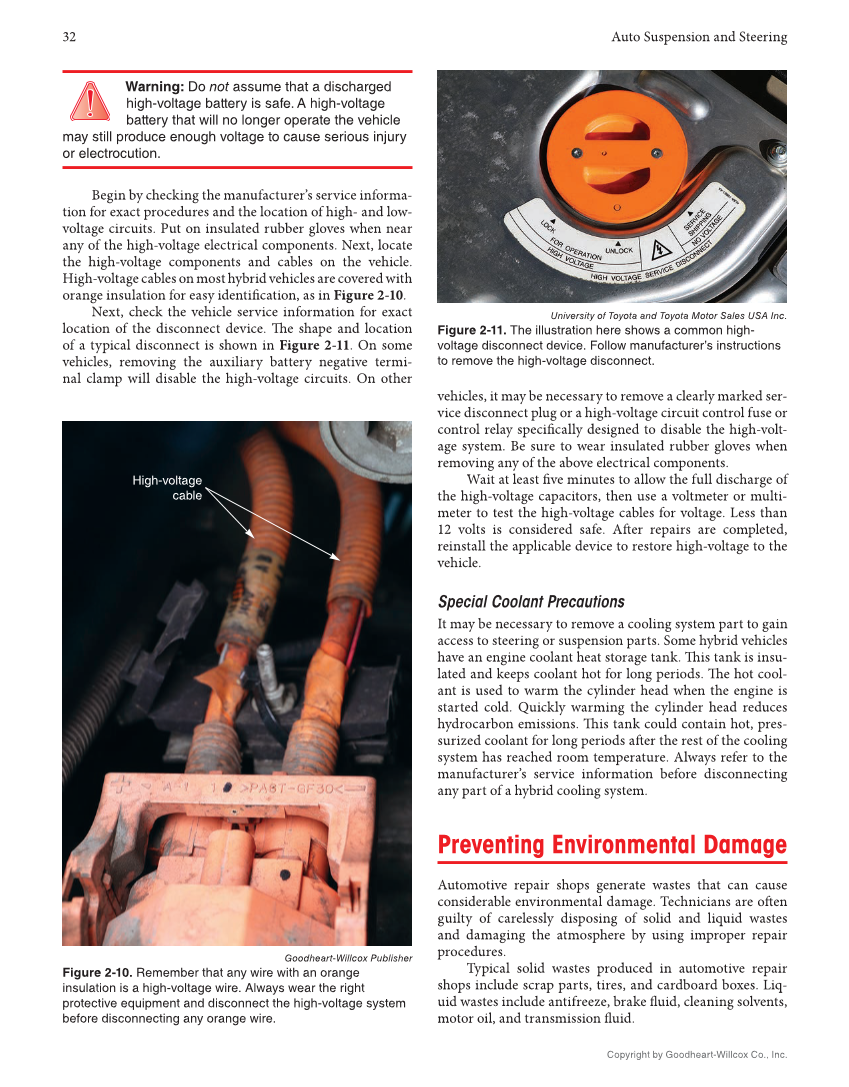32 Auto Suspension and Steering Copyright by Goodheart-Willcox Co., Inc. Warning: Do not assume that a discharged high-voltage battery is safe. A high-voltage battery that will no longer operate the vehicle may still produce enough voltage to cause serious injury or electrocution. Begin by checking the manufacturer’s service informa- tion for exact procedures and the location of high- and low- voltage circuits. Put on insulated rubber gloves when near any of the high-voltage electrical components. Next, locate the high-voltage components and cables on the vehicle. High-voltage cables on most hybrid vehicles are covered with orange insulation for easy identifi cation, as in Figure 2-10. Next, check the vehicle service information for exact location of the disconnect device. Th e shape and location of a typical disconnect is shown in Figure 2-11. On some vehicles, removing the auxiliary battery negative termi- nal clamp will disable the high-voltage circuits. On other vehicles, it may be necessary to remove a clearly marked ser- vice disconnect plug or a high-voltage circuit control fuse or control relay specifi cally designed to disable the high-volt- age system. Be sure to wear insulated rubber gloves when removing any of the above electrical components. Wait at least fi ve minutes to allow the full discharge of the high-voltage capacitors, then use a voltmeter or multi- meter to test the high-voltage cables for voltage. Less than 12 volts is considered safe. Aft er repairs are completed, reinstall the applicable device to restore high-voltage to the vehicle. Special Coolant Precautions It may be necessary to remove a cooling system part to gain access to steering or suspension parts. Some hybrid vehicles have an engine coolant heat storage tank. Th is tank is insu- lated and keeps coolant hot for long periods. Th e hot cool- ant is used to warm the cylinder head when the engine is started cold. Quickly warming the cylinder head reduces hydrocarbon emissions. Th is tank could contain hot, pres- surized coolant for long periods aft er the rest of the cooling system has reached room temperature. Always refer to the manufacturer’s service information before disconnecting any part of a hybrid cooling system. Preventing Environmental Damage Automotive repair shops generate wastes that can cause considerable environmental damage. Technicians are oft en guilty of carelessly disposing of solid and liquid wastes and damaging the atmosphere by using improper repair procedures. Typical solid wastes produced in automotive repair shops include scrap parts, tires, and cardboard boxes. Liq- uid wastes include antifreeze, brake fl uid, cleaning solvents, motor oil, and transmission fl uid. High-voltage cable Goodheart-Willcox Publisher Figure 2-10. Remember that any wire with an orange insulation is a high-voltage wire. Always wear the right protective equipment and disconnect the high-voltage system before disconnecting any orange wire. University of Toyota and Toyota Motor Sales USA Inc. Figure 2-11. The illustration here shows a common high- voltage disconnect device. Follow manufacturer’s instructions to remove the high-voltage disconnect.
